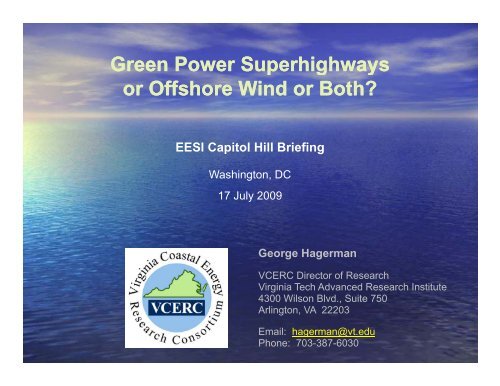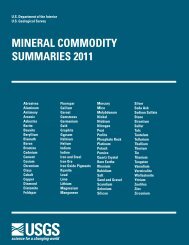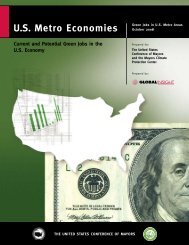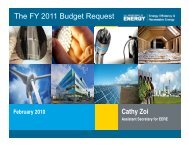George Hagerman - Environmental and Energy Study Institute
George Hagerman - Environmental and Energy Study Institute
George Hagerman - Environmental and Energy Study Institute
Create successful ePaper yourself
Turn your PDF publications into a flip-book with our unique Google optimized e-Paper software.
Green Power Superhighways<br />
or Offshore Wind or Both?<br />
EESI Capitol Hill Briefing<br />
Washington, DC<br />
17 July 2009<br />
<strong>George</strong> <strong>Hagerman</strong><br />
VCERC Director of Research<br />
Virginia Tech Advanced Research <strong>Institute</strong><br />
4300 Wilson Blvd., Suite 750<br />
Arlington, VA 22203<br />
Email: hagerman@vt.edu<br />
Phone: 703-387-6030
Presentation Outline<br />
Proposal for “Green Power Superhighway” in context<br />
with magnitude <strong>and</strong> distribution ib ti of US wind resources<br />
Offshore wind technology overview<br />
Economic development benefits of offshore wind for<br />
local maritime economies <strong>and</strong> job creation potential<br />
<strong>Energy</strong> security <strong>and</strong> long-term price stability benefits to<br />
U.S Navy; alignment with DOD RPS (25% by 2025)<br />
Ongoing NREL <strong>and</strong> utility modeling of US 20% wind<br />
scenarios will help inform policy making; recommend<br />
exp<strong>and</strong>ing to include economic development impacts<br />
<strong>and</strong> adding other renewable energy resources
Green Power Superhighway Concept<br />
See www.awea.org/GreenPowerSuperhighways.pdf for full report
Nearly 60% of U.S. Population Lives in Atlantic,<br />
Pacific, Gulf of Mexico or Great Lakes States<br />
Twenty-eight coastal states in contiguous U.S. are home to 58% of population
Nearly 80% of U.S. Electricity Dem<strong>and</strong> is in Atlantic,<br />
Pacific, Gulf of Mexico or Great Lakes States<br />
Twenty-eight coastal states in contiguous U.S. consume 78% of U.S. electrical energy
U.S. Offshore Wind Resources<br />
Pacific NW<br />
Class 5, 6 & 7<br />
Gulf of Maine<br />
Class 6<br />
Great Lakes<br />
Class 5 & 6<br />
Mid-Atlantic<br />
Class 5 & 6<br />
S California<br />
Class 4, 5 & 6<br />
Great Plains<br />
Class 3, 4 & 5<br />
Southeast<br />
Class 4, 5 & 6
US Offshore Wind Resources Located<br />
Near Coastal Metropolitan Load Centers
Typical Offshore Wind Farm Layout
Monopile Foundations Driven into Seabed<br />
<strong>and</strong> Transition Pieces Grouted on Top
Horns Rev 2-MW Turbines<br />
Installed Using Self-Propelled A2 SEA Vessels
North Hoyle 2-MW Turbines<br />
Installed Using Towed Seacore Jack-Up Rigs
Two-Thirds of the Capital Cost of an Offshore<br />
Wind Project is in the Turbine & Tower Package<br />
Turbine & Tower Package<br />
66%
Less than One-Eighth of the Capital Cost<br />
is in Submarine Power Cable Fabrication<br />
Turbine & Tower Package<br />
66%<br />
Power Collection: 6%<br />
Power Transmission: 5%
Nearly a Quarter of the Total Project<br />
Capital Investment Engages the Local Economy<br />
Turbine & Tower Package<br />
66%<br />
Power Collection: 6%<br />
Power Transmission: 5%<br />
Project Management<br />
2%<br />
Local Balance of Plant<br />
21%
Wind <strong>Energy</strong> Jobs in the European Union<br />
Breakdown by Type of Activity <strong>and</strong> per Megawatt
Secure <strong>and</strong> Price-Stable <strong>Energy</strong> Supply<br />
for Navy’s Virginia Capes Operating Area
Secure <strong>and</strong> Price-Stable <strong>Energy</strong> Supply<br />
for Navy’s Virginia Capes Operating Area
Secure <strong>and</strong> Price-Stable <strong>Energy</strong> Supply<br />
for Navy’s Virginia Capes Operating Area
Secure <strong>and</strong> Price-Stable <strong>Energy</strong> Supply<br />
for Navy’s Virginia Capes Operating Area
GIS Analysis <strong>and</strong> Mapping of Resource<br />
Focus on 50 MMS lease blocks <strong>and</strong> avoid all excluded areas<br />
MMS lease blocks are<br />
4.8 km x 4.8 km, with each<br />
block having 7 x 7 turbines.<br />
Turbines spaced 685 m<br />
apart (7.6 rotor diameters)<br />
Each lease block could<br />
contain 49 turbines<br />
= 147 MW per block with<br />
Vestas model V-90 3 MW<br />
= 6.4 MW per km 2<br />
GIS layers <strong>and</strong><br />
calculations by<br />
James Madison<br />
University
Class 6 Winds are<br />
Largely Beyond the Visual Horizon<br />
Photo simulation of Long Isl<strong>and</strong> offshore wind project<br />
12 n.mi.
Class 6 Winds are<br />
Largely Beyond the Visual Horizon<br />
Photo simulation of Long Isl<strong>and</strong> offshore wind project<br />
Beyond the<br />
Territorial Sea Limit<br />
of 12 n.mi.,<br />
turbines would<br />
be barely visible,<br />
<strong>and</strong> then only on<br />
the clearest days.<br />
12 n.mi.
Class 6 Winds are<br />
Largely Beyond the Visual Horizon<br />
Photo simulation of Long Isl<strong>and</strong> offshore wind project<br />
Beyond the<br />
Territorial Sea Limit<br />
of 12 n.mi.,<br />
turbines would<br />
be barely visible,<br />
<strong>and</strong> then only on<br />
the clearest days.<br />
12 n.mi.<br />
Total available<br />
area of Class 6<br />
beyond 12 n.mi.<br />
is 575.6 sq.km<br />
(142,500 acres);<br />
could support<br />
3,680 MW of<br />
wind capacity.
U.S. DOE “20% Wind <strong>Energy</strong> by 2030”<br />
ty (GW)<br />
300<br />
250<br />
Offshore<br />
L<strong>and</strong>-based<br />
53.9 GW<br />
offshore<br />
ed Capaci<br />
tive Install<br />
200<br />
150<br />
100<br />
293.4 GW<br />
on l<strong>and</strong><br />
Cumulat<br />
50<br />
2009<br />
0<br />
2000 2006 2012 2018 2024 2030
Ten Eastern States have Shallow-Water<br />
Offshore Wind Resources Comparable to Dem<strong>and</strong><br />
ME<br />
MI<br />
OH<br />
NJ<br />
DE<br />
MA<br />
RI<br />
VA<br />
NC<br />
SC
Ten Eastern States have Shallow-Water<br />
Offshore Wind Resources Comparable to Dem<strong>and</strong><br />
ME<br />
MI<br />
MA<br />
RI<br />
A notional offshore wind build-out to support<br />
the “20% Wind <strong>Energy</strong> by 2030”plan can be<br />
estimated as 5.4 gigawatts in each of these ten<br />
states, or 5,400 MW, to be commissioned<br />
between 2011 <strong>and</strong> 2030. This corresponds to<br />
each state installing one 540 MW project every<br />
two years for the next 20 years, at which time<br />
the first projects will be ready for re-powering.<br />
OH<br />
VA<br />
NC<br />
SC<br />
NJ<br />
DE
Ten Eastern States have Shallow-Water<br />
Offshore Wind Resources Comparable to Dem<strong>and</strong><br />
ME<br />
MI<br />
MA<br />
RI<br />
A notional offshore wind build-out to support<br />
the “20% Wind <strong>Energy</strong> by 2030”plan can be<br />
estimated as 5.4 gigawatts in each of these ten<br />
states, or 5,400 MW, to be commissioned<br />
between 2011 <strong>and</strong> 2030. This corresponds to<br />
each state installing one 540 MW project every<br />
two years for the next 20 years, at which time<br />
the first projects will be ready for re-powering.<br />
OH<br />
VA<br />
NC<br />
SC<br />
NJ<br />
DE<br />
Maritime regional economies in all coastal states would<br />
Maritime regional economies in all coastal states would<br />
benefit, but this economic development potential could be<br />
threatened by federally funded Green Power Superhighway
NREL Eastern Wind Integration<br />
<strong>and</strong> Transmission <strong>Study</strong> (EWITS)<br />
Scenario 1, 20% wind penetration – Lowest Cost Wind: Utilizes<br />
high quality wind resources in the Great Plans, with other<br />
development in the east where good wind resources exist. Total<br />
capacity in MISO, MAPP, <strong>and</strong> SPP approximately 185 GW.<br />
Scenario 2, 20% wind penetration – Hybrid, with Offshore: Some<br />
wind generation in the Great Plains is moved east, with capacity<br />
increased in PJM, NYISO, <strong>and</strong> ISO-NE. Some offshore<br />
development in the Northeast t <strong>and</strong> Mid-Atlantic.<br />
ti<br />
Scenario 3, 20% wind penetration – Load-weighted Wind<br />
Development, Aggressive Offshore: More wind is moved east<br />
toward load centers, with much greater offshore development.<br />
See http://wind.nrel.gov/public/EWITS p <strong>and</strong> www.jcspstudy.org<br />
for further information, including reports <strong>and</strong> presentations
EWITS Scenario 1
EWITS Scenario 2
EWITS Scenario 3
Scenario 1 Annual Load Weighted Wholesale<br />
Power Cost (Localized Marginal Price)
Conclusions <strong>and</strong> Recommendations<br />
Consideration of proposals for a federally subsidized<br />
Green Power Superhighway should carefully weigh<br />
impact on coastal states’ ability to develop their own<br />
secure <strong>and</strong> sustainable energy supplies<br />
Impact on local wholesale power prices is now being<br />
modeled for three “20% US wind” scenarios under<br />
the Eastern Wind Integration <strong>and</strong> Transmission<br />
<strong>Study</strong> <strong>and</strong> results will help inform policy making<br />
EWITS analysis should be exp<strong>and</strong>ed to include impact<br />
on local economic development <strong>and</strong> job creation in<br />
all affected states, as well as adding simulation of<br />
other major renewable energy resources (e.g. solar,<br />
biomass) as an integrated US energy supply system
Thank You!<br />
Any questions?<br />
Email: hagerman@vt.edu







